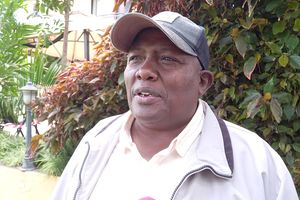Premium
This is what makes Lake Paradise, home of big tuskers, tick
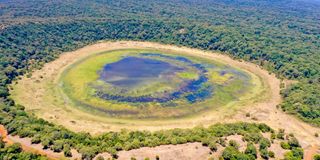
A picture of Lake Paradise ringed by the scenic Marsabit forest taken on September 17, 2020. The lake has cradled some of the elephants with the biggest tusks in the world.
What you need to know:
- Lake Paradise has been famed as one of the jewels of Northern Kenya.
- It is also the home to the legendary elephants Ahmed and Abdul.
For many years, Marsabit has piqued the interests of many nature lovers for its diverse heritage and tourist attraction sites, which combine to form the ultimate experience and the treasure trove of a once marginalised region.
One of these sites is Lake Paradise, a beautiful crater lake where life for years has remained remarkably the same and wildlife is flourishing, thanks to smart conservation efforts by the government and locals.
It sits atop an extinct volcano at the height of 1,340 metres above sea level and on the cliff edges of Mt Marsabit.
One gets blown away by the assortment of the awe-inspiring scenery, flora and fauna within the park and the flagrantly positioned crater lake at the heart of Marsabit Forest.
Lake Paradise has been famed as one of the jewels of Northern Kenya and the home to the legendary elephants Ahmed and Abdul among many others. These are jumbos that had the longest tusks in Kenya.
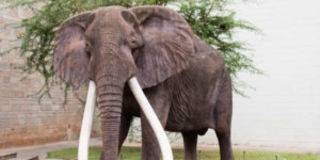
An exhibit of the legendary elephant Ahmed at the Kenya National Museum in Nairobi.
It is ringed by the scenic forest, which is under the constant guard of Kenya Wildlife Service and the Kenya Forest Service rangers.
Here, the harsh desert climatic conditions attributed to Marsabit County instantaneously vanish from the mind.
The forest bestows Marsabit town with a unique climatic condition, of misty and chilly mornings during rainy seasons similar to that of Mt Kenya regions.
The lake earned its global acknowledgement from a couple, filmmakers and authors Martin Elmer Johnson and his wife Osa Helen Johnson, in their films and books of adventure in the exotic and faraway lands.
During their second and longest trip, from 1924 to 1927, the Johnsons spent much of their time in Northern Kenya and specifically by Lake Paradise, at Mt Marsabit.
The movies Martin's Safari (1928), Osa's Four Years in Paradise (1941), and the film Simba: King of the Beasts (1928) were made with footage of those trips.
She wrote in her book, I Married Adventure (1940), about an unknown mystical crater lake at the heart of Marsabit Forest, a secretively guarded place from the white man and his gun.
Seventy years later, after reading the book, former Game Department Assistant Collector Blaney Percival set out on a journey and expedition to trace the hidden unknown pearl in the then rugged Mount Marsabit.
He later recounted in his book Game Ranger’s Note Book (2017) how the exclusive crater lake’s name popped up in a conversation that ensued between the couples; Martin Elmer and Osa Johnson.
“The lake was shaped like a spoon, almost a quarter of a mile wide and three-quarters of a mile long, and it sloped up into steep, wooded banks two hundred feet high. A tangle of water-vines and lilies — great African lilies — grew in the shallows at the water’s edge. Wild ducks, cranes and egrets, circled and dipped. Animals, more than we could count, stood quietly knee-deep in the water and drank.”
“It’s Paradise, Martin!” I said.
He nodded.
That was how Lake Paradise was given its name.”
~ Blaney Percival~
The locals refer to the lake as Gof Sokorte Gurda, a Borana word for the big sweet water crater.
Most famed elephants
Not far from the lake is another smaller but similar lake, inside the forest known as 'Gof Sokorte Dika' or 'Small sweet water crater' — a popular retreat for elephants.
Just a few kilometres on the eastern side is another smaller crater lake known as Goff Bongole.
Together, the three are some of the best places to spot animals, as the rest of the park is covered in dense forest.
These three unique lakes have always provided a sanctuary for diverse species of animals and birds including the gravy zebras, buffaloes, black and white colobus, blue monkeys, bushbucks, sunis, and leopards, which populate the park.
According to the Northern KWS Assistant Director Robert Obrein, the park comprises more than 350 species of birds, 52 of which are birds of prey.
The cliff in the northern end of Lake Paradise is Gof Sokortye Gurda, which is home to several birds, including Ruppell’s griffon vultures, peregrine falcon, buzzards, black kites and African fish eagles.
Ducks such as garganeys, southern porchards, and teals are found on the lake, which is also home to red-knobbed coots, hamerkops, ibises, purple herons, and yellow-billed storks.
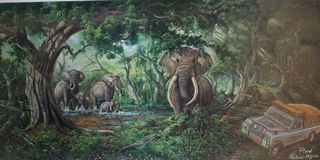
Richard Onyango's memories of the elephant Ahmed, Africa's largest elephant protected by govrenment Land Rover.
On the lower slopes of the forest of the park, marked by scrubland, there are populations of olive baboons, vervet monkeys, Peter's gazelles, beisa oryxes, striped hyenas, caracals and aardwolves.
Mr Obrien added that traditionally, the locals have a sentimental attachment to Lake Paradise as they use its water in their cultural festivities besides it being a meeting zone of various species of animals.
“The locals depend so much on Lake Paradise and the two other crater lakes whose water is used in their sacred rituals and during cultural festivities,” he said.
Mount Marsabit became the habitat of the world’s most famed elephants that lived in the 1970s which had the biggest tusks in the world.
They would be sighted drinking water at Lake Paradise or Sorkote Gurda during dry seasons.
According to Marsabit County Documentation Officer Rehman Moghal, Ahmed, the legendary elephant, was named the King of Marsabit due to his galactic tusks which weighed 67.2kg each by the time of his death.
“I had the opportunity to see the legendary elephant Ahmed and even another one called Abdul many times when they were alive and I can tell you they were a rare spectacle to relish,’’ Mzee Moghal said.
His tusks were presumed to be the longest and heaviest in Africa.
He was born in 1919 at a time when poaching was on the rise and named Ahmed after one of the rangers who were then known as scouts.
Two scouts were initially charged with the duty to protect the orphaned Ahmed whose parents died at the hands of poachers.
National treasure
Mzee Moghul recalls that Ahmed stood out for his docility, a loner and elusive, human-friendly tendencies perhaps having grown under the close watch of the rangers.
He was constantly accompanied by two other bull elephants wherever he went.
Shockingly, the two comparatively smaller bull elephants and who were named askaris by the locals, were the ones who would behave combatively towards any deemed aggressors.
His tusks were so large that in 1970, he was declared a national treasure and living monument by President Jomo Kenyatta and also granted protection of five armed bodyguards who were charged with the duty of keeping round the clock watch on him.
Ahmed featured in three films almost concurrently: The ABC series The American Sportsman featuring director John Huston in "The Search for Ahmed."
An NBC film with George Plimpton followed, as well as a French documentary highlighting the work of Iain Douglas-Hamilton.
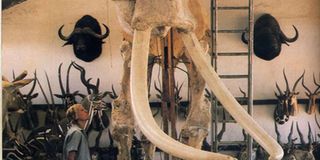
Before it closed shop in 1977 after the ban on hunting, the Zimmermann taxidermy factory was the second-largest in the world. It was here where the elephant Ahmed was brought for mounting after its death. Tim Nicklin is pictured here at Zimmermann's where he worked.
The presidential decree came after Ahmed grabbed global attention in the media onslaught that aroused letter-writing appeals by schoolchildren in 1970 asking the first president to protect that extraordinary national pearl.
He was found standing still with his eyes closed but leaning on his side against a tree and supported by his tusk one morning in 1974 after an intensive search mounted by the guards who lost sight of him for a few days.
He died aged 55 years.
His killing was reportedly executed intelligently by unknown hunters who shot him as a bullet was found lodged in his stomach, according to the author of The Hunter and the Go-Away Bird, Steve Smith, who was also a famous professional hunter in Kenya.
Mr Moghal maintained that even to date, the descendants of Ahmed still roam the Marsabit National Park.
Ahmed can still be seen today as an exhibit at the Kenya National Museums in Nairobi.
Marsabit County Tourism and Culture Director Abdullahi Ibrahim described Marsabit as a county of many faces compared to a beautiful sloe-eyed empress whose happiness radiates like a flower and who steals many young men’s hearts despite its many years of under-development.
He held that for anyone longing for an extraordinary getaway with that special person, Mount Marsabit within Marsabit National Park was ready to welcome them for exciting, safe and affordable and unforgettable experiences.
He added that his department works hard to provide recreational avenues for elemental changes in the tourism industry especially at a time when life was too dull and crowded towns were beginning to be given wide berths by foreign tourists.



